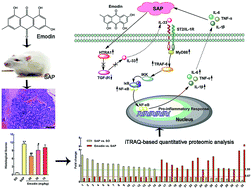iTRAQ-based quantitative proteomic analysis for identification of biomarkers associated with emodin against severe acute pancreatitis in rats†
Abstract
In the present work, we investigated the action of emodin against rats with severe acute pancreatitis (SAP) induced by administering 5% sodium taurocholate. The results demonstrated that emodin markedly decreased plasma amylase, lipase, IL-1β, IL-6 and TNF-α activities. Immunohistochemistry and immunofluorescence results indicated that emodin down-regulated MPO protein expression. Meanwhile, emodin improved pancreatic histopathology and acinous cell ultrastructure. In addition, real-time PCR results also proved that emodin significantly inhibited IL-1β, IL-6 and TNF-α mRNA expression. Finally, a total of 32 differentially expressed proteins from rat pancreas in response to stimulus were discovered by using iTRAQ-based quantitative proteomic analysis. These proteins were related to each other and involved in different biological processes. Among them, a new biomarker, HTRA1, was found to associate with SAP, which was validated by western blot. Further work found, for the first time, that proteins in the HTRA1/TGF-β1 signaling cascade including HTRA1, TGF-β1, IL-33, MyD88, TRAF6 and NF-κB were involved in the mechanisms of emodin against SAP. Ultimately, our results suggested that emodin had potent actions against SAP injury by inhibiting the HTRA1/TGF-β1 signaling pathway and subsequent inflammatory responses. These findings provide new insights that will aid in illuminating the action of emodin against SAP insult.


 Please wait while we load your content...
Please wait while we load your content...